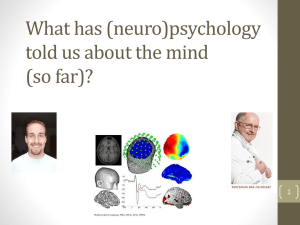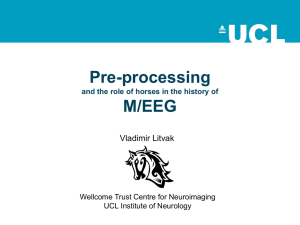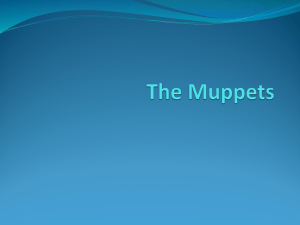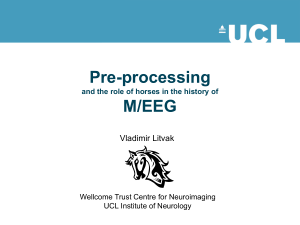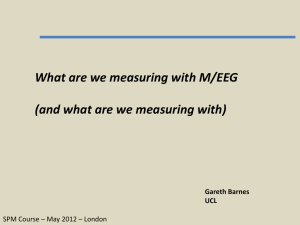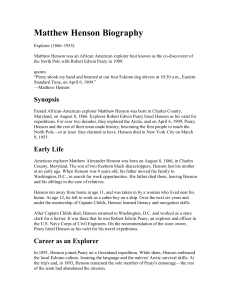05_MEEG_StatsPractica
advertisement
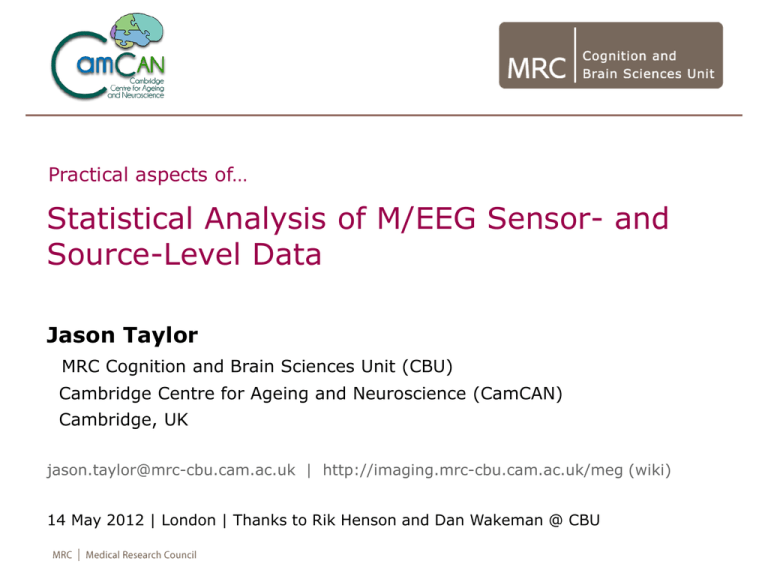
Practical aspects of… Statistical Analysis of M/EEG Sensor- and Source-Level Data Jason Taylor MRC Cognition and Brain Sciences Unit (CBU) Cambridge Centre for Ageing and Neuroscience (CamCAN) Cambridge, UK jason.taylor@mrc-cbu.cam.ac.uk | http://imaging.mrc-cbu.cam.ac.uk/meg (wiki) 14 May 2012 | London | Thanks to Rik Henson and Dan Wakeman @ CBU Overview The SPM approach to M/EEG Statistics: A mass-univariate statistical approach to inference regarding effects in space/time/frequency (using replications across trials or subjects). • In Sensor Space: 2D Time-Frequency 3D Topography-by-Time • In Source Space: 3D Time-Frequency contrast images 4-ish-D space by (factorised) time Alternative approaches: SnPM, PPM, etc. Example Datasets CTF Multimodal Face-Evoked Dataset | SPM8 Manual (Rik Henson) CTF MEG/ActiveTwo EEG: 275 MEG 128 EEG 3T fMRI (with nulls) 1mm3 sMRI 2 sessions Stimuli: ~160 face trials/session ~160 scrambled trials/session Group: N=12 subjects (Henson et al, 2009 a,b,c) Chapter 37 SPM8 Manual Neuromag Faces Dataset | Dan Wakeman & Rik Henson @ CBU Neuromag MEG & EEG Data: 102 Magnetometers 204 Planar Gradiometers 70 EEG HEOG, VEOG, ECG 1mm3 sMRI 400600ms 8001000ms 1700ms 6 sessions Stimuli: faces & scrambled-face images (480 trials total) Group: N=18 (Henson et al, 2011) Biomag 2010 Award-Winning Dataset! Neuromag Lexical Decision Dataset | Taylor & Henson @ CBU Neuromag MEG Data: 102 Magnetometers 204 Planar Gradiometers HEOG, VEOG, ECG 1mm3 sMRI 4 sessions Stimuli: words & pseudowords presented visually (480 trials total) Group: N=18 Taylor & Henson (submitted) Neuromag Lexical Decision The Multiple Comparison Problem Where is the effect?: The curse of too much data The Multiple Comparison Problem • The more comparisons we conduct, the more Type I errors (false positives) we will make when the Null Hypothesis is true. * Must consider Familywise (vs. per-comparison) Error Rate • Comparisons are often made implicitly, e.g., by viewing (“eyeballing”) data before selecting a time-window or set of channels for statistical analysis. RFT correction depends on the search volume. -> When is there an effect in time e.g., GFP (1D)? time The Multiple Comparison Problem • The more comparisons we conduct, the more Type I errors (false positives) we will make when the Null Hypothesis is true. * Must consider Familywise (vs. per-comparison) Error Rate Comparisons are often made implicitly, e.g., by viewing (“eyeballing”) data before selecting a time-window or set of channels for statistical analysis. RFT correction depends on the search volume. -> When/at what frequency is there an effect an effect in time/frequency (2D)? frequency • time The Multiple Comparison Problem • The more comparisons we conduct, the more Type I errors (false positives) we will make when the Null Hypothesis is true. * Must consider Familywise (vs. per-comparison) Error Rate • Comparisons are often made implicitly, e.g., by viewing (“eyeballing”) data before selecting a time-window or set of channels for statistical analysis. RFT correction depends on the search volume. x -> When/where is there an effect in sensor-topography space/time (3D)? y The Multiple Comparison Problem • The more comparisons we conduct, the more Type I errors (false positives) we will make when the Null Hypothesis is true. * Must consider Familywise (vs. per-comparison) Error Rate • Comparisons are often made implicitly, e.g., by viewing (“eyeballing”) data before selecting a time-window or set of channels for statistical analysis. RFT correction depends on the search volume. -> When/where is there an effect in source space/time x (4-ish-D)? z y The Multiple Comparison Problem • The more comparisons we conduct, the more Type I errors (false positives) we will make when the Null Hypothesis is true. * Must consider Familywise (vs. per-comparison) Error Rate • Comparisons are often made implicitly, e.g., by viewing (“eyeballing”) data before selecting a time-window or set of channels for statistical analysis. RFT correction depends on the search volume. Random Field Theory (RFT) is a method for correcting for multiple statistical comparisons with N-dimensional spaces (for parametric statistics, e.g., Z-, T-, F- statistics). * Takes smoothness of images into account Worsley Et Al (1996). Human Brain Mapping, 4:58-73 GLM: Condition Effects after removing variance due to confounds Each trial-type (6) Confounds (4) Each trial W/in Subject (1st-level) model -> one image per trial -> one covariate value per trial Also: Group Analysis (2nd-level) -> one image per subject per condition -> one covariate value per subject per condition beta_00* image volumes reflect (adjusted) condition effects Henson et al., 2008, NImage Sensor-space analyses Where is an effect in time-frequency space? 1 subject (1st-level analysis) 1 MEG channel Faces > Scrambled Faces Morlet wavelet projection Scrambled 1 t-x-f image per trial Kilner et al., 2005, Nsci Letters CTF Multimodal Faces Where is an effect in time-frequency space? 18 subjects 1 channel (2nd-level analysis) Faces > Scrambled EEG MEG (Mag) 6 6 Freq (Hz) Freq (Hz) 90 90 100-220ms 8-18Hz -500 +1000 Time (ms) -500 +1000 Time (ms) Neuromag Faces Where is an effect in sensor-time space? 1 subject ALL EEG channels 3D Topographyx-Time Image volume (EEG) time Each trial, Topographic projection (2D) for each time point (1D) = topo-time image volume (3D) Faces vs Scrambled y x CTF Multimodal Faces Where is an effect in sensor-time space? Analysis over subjects (2nd Level) NOTE for MEG: Complicated by variability in head-position SOLUTION(?): Virtual transformation to same position (sessions, subjects) - using Signal Space Separation (SSS; Taulu et al, 2005; Neuromag systems) Without transformation to Device Space With transformation to Device Space Stats over 18 subjects, RMS of planar gradiometers Improved: (i.e., more blobs, larger T values) w/ head-position transform Other evidence: ICA ‘splitting’ with movement Taylor & Henson (2008) Biomag Neuromag Lexical Decision Where is an effect in sensor-time space? Analysis over subjects (2nd Level): Magnetometers: Pseudowords vs Words PPM (P>.95 effect>0) Effect Size 18 fT -18 Taylor & Henson (submitted) Neuromag Lexical Decision Source-space analyses Where is an effect in source space (3D)? STEPS: Estimate evoked/induced energy (RMS) at each dipole for a certain time-frequency window of interest. - e.g., 100-220ms, 8-18 Hz - For each condition (Faces, Scrambled) - For each sensor type OR fused modalities Write data to 3D image - in MNI space - smooth along 2D surface Smooth by 3D Gaussian Submit to GLM Henson et al., 2007, NImage Where is an effect in source space (3D)? RESULTS: Faces > Scrambled fMRI EEG MEG sensor fusion E+MEG Henson et al, 2011 Neuromag Faces Where is an effect in source space (3D)? RESULTS: Faces > Scrambled fMRI with group optimised fMRI priors EEG+MEG+fMRI with fMRI priors EEG+MEG+fMRI mean stats Henson et al, 2011 Neuromag Faces Where and When do effects emerge/disappear in source space (4-ish-D: time factorised)? Condition x Time-window Interactions Factorising time allows you to infer (rather than simply describe) when effects emerge or disappear. We've used a data-driven method (hierarchical cluster analysis) in sensor space to define timewindows of interest for source-space analyses. * high-dimensional distance between topography vectors * cut the cluster tree where the solution is stable over longest range of distances Taylor & Henson, submitted Neuromag Lexical Decision Where and When do effects emerge/disappear in source space (4-ish-D)? Condition x Time-window Interactions Factorising time allows you to infer (rather than simply describe) when effects emerge or disappear. source timecourses We've used a data-driven method (hierarchical cluster analysis) in sensor space to define time-windows of interest for source-space analyses. * estimate sources in each sub-time-window * submit to GLM with conditions & time-windows as factors (here: Cond effects per t-win) Taylor & Henson, submitted Neuromag Lexical Decision Where and When do effects emerge/disappear in source space (4-ish-D)? Condition x Time-window Interactions Factorising time allows you to infer (rather than simply describe) when effects emerge or disappear. We've used a data-driven method (hierarchical cluster analysis) in sensor space to define time-windows of interest for source-space analyses. * estimate sources in each subtime-window * submit to GLM with conditions & time-windows as factors: Cond x TW interactions Taylor & Henson, submitted Neuromag Lexical Decision Alternative Approaches Alternative Approaches Classical SPM approach: Caveats Inverse operator induces long-range error correlations (e.g., similar gain vectors from non-adjacent dipoles with similar orientation), making RFT correction conservative Distributions over subjects/voxels may not be Gaussian (e.g., if sparse, as in MSP) (Taylor & Henson, submitted; Biomag 2010) Alternative Approaches Non-Parametric Approach (SnPM) p<.05 FWE Robust to non-Gaussian distributions Less conservative than RFT when dfs<20 Caveats: No idea of effect size (e.g., for power, future expts) Exchangeability difficult for more complex designs (Taylor & Henson, Biomag 2010) SnPM Toolbox by Holmes & Nichols: http://go.warwick.ac.uk/tenichols/software/snpm/ CTF Multimodal Faces Alternative Approaches Posterior Probability Maps (PPMs) p>.95 (γ>1SD) Bayesian Inference No need for RFT (no MCP) Threshold on posterior probabilty of an effect greater than some size Can show effect size after thresholding Caveats: Assume Gaussian distribution (e.g., of mean over voxels) CTF Multimodal Faces Future Directions • Extend RFT to 2D cortical surfaces (+1D time)? (e.g., Pantazis et al., 2005, NImage) • Novel approaches to controlling for multiple comparisons (e.g., 'unique extrema' in sensors: Barnes et al., 2011, NImage) • Go multivariate? To identify linear combinations of spatial (sensor or source) effects in time and space (e.g., Carbonnell, 2004, NImage; but see Barnes et al., 2011) To detect spatiotemporal patterns in 3D images (e.g., Duzel, 2004, NImage; Kherif, 2003, NImage) -- The end -- • Thanks for listening • Acknowledgements: • Rik Henson (MRC CBU) • Dan Wakeman (MRC CBU / now at MGH) • Vladimir, Karl, and the FIL Methods Group • More info: • http://imaging.mrc-cbu.cam.ac.uk/meg (wiki) jason.taylor@mrc-cbu.cam.ac.uk

